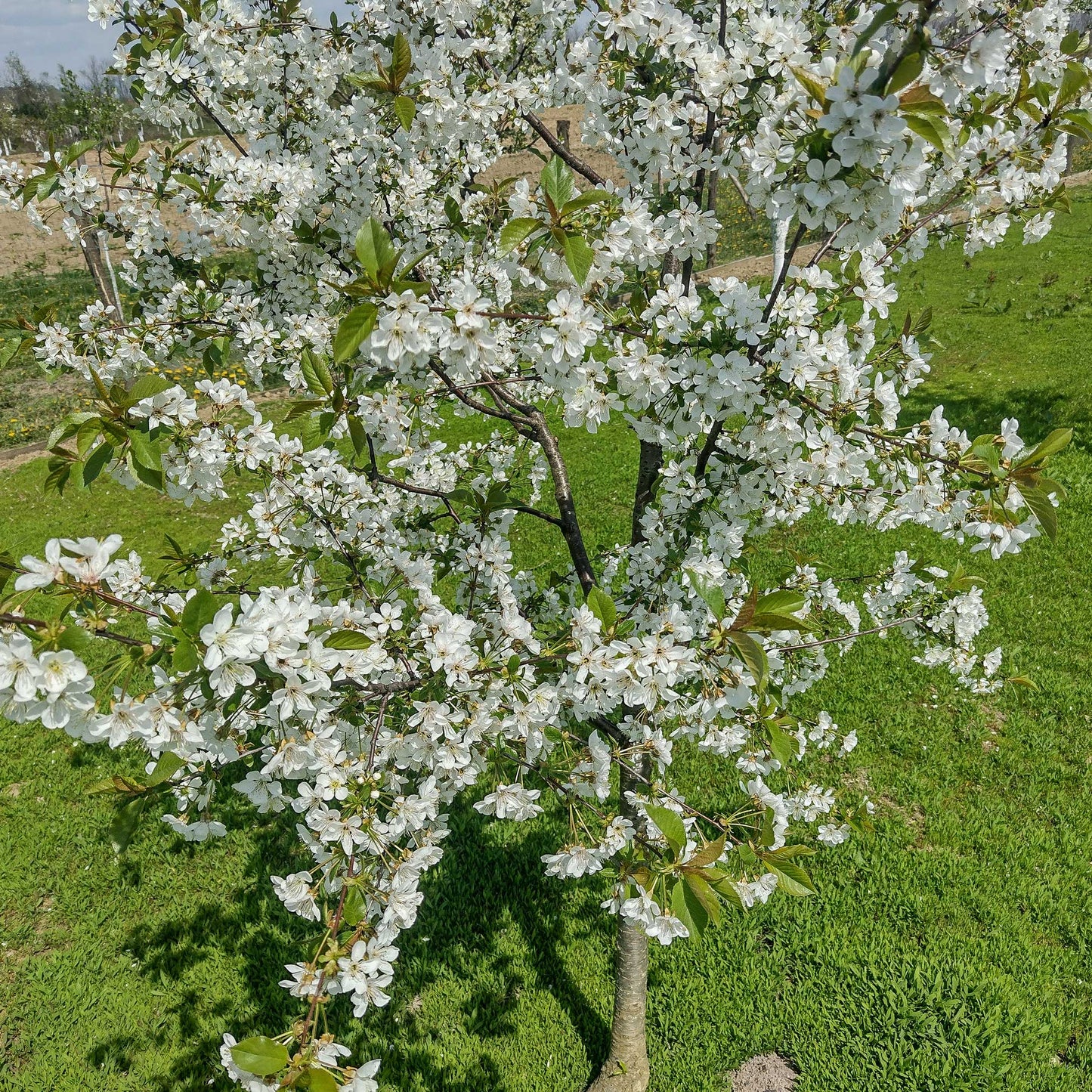Lapins Cherry Tree
Lapins Cherry Tree
SKU:EDI-CHE-LAP-67-5G
Meet the Luscious Lapins Cherry Tree!
Imagine stepping into your garden and plucking a sun-warmed, sweet cherry straight from the branch. With the Lapins Cherry Tree, that dream becomes your backyard reality! This self-pollinating superstar is a must-have for any fruit lover looking for a hassle-free harvest.
Easy Peasy Cherry Squeezy
No need for a partner plant here! The Lapins Cherry Tree stands tall and proud on its own, producing an abundance of deep, burgundy cherries every year. It's like having a personal cherry festival right in your own garden!
Beauty Beyond the Fruit
But it's not just about the cherries. This tree is a stunner throughout the seasons. In spring, it's a cloud of delicate white blossoms, and in fall, it puts on a fiery show of autumn colors. It's a year-round charmer!
Perfect for Patios and Small Spaces
Worried about space? Don't be! The Lapins Cherry Tree is compact enough for small gardens and can even thrive in a container on your patio. It's the tree that fits your life, no matter the size of your green space.




Product Details
-
Product Category
Edibles
-
Product Subcategory:
Cherry Trees
-
Botanical Name:
Prunus avium 'Lapins'
-
Does Not Ship To:
AZ, CA, ID, WA, OR
-
Mature Height:
15-20 ft.
-
Mature Width:
10-15 ft.
-
Growing Zone:
5-9 outdoors
-
Indoor Growing:
-
Sunlight:
Full Sun
-
Growth Rate:
Moderate
-
Harvest Time:
May-June
-
Bloom Time:
Spring

Planting Directions
<h2>Planting Lapins Cherry Tree</h2>
<ul>
<li>Choose a sunny site with well-draining soil.</li>
<li>Test soil pH; cherries prefer a pH of 6.0 to 7.0.</li>
<li>Space trees 20-25 feet apart to ensure adequate air circulation.</li>
<li>Dig a hole twice as wide and the same depth as the root ball.</li>
<li>Place the tree in the hole, spreading roots outward.</li>
<li>Backfill the hole with soil, watering deeply to settle the roots.</li>
<li>Add a layer of mulch around the base to conserve moisture.</li>
</ul>
<h2>Care and Maintenance</h2>
<ul>
<li>Water regularly, especially during dry spells.</li>
<li>Apply a balanced fertilizer in early spring before new growth begins.</li>
<li>Prune in late winter to remove dead or crossing branches and to shape the tree.</li>
<li>Monitor for pests and diseases, and treat as necessary.</li>
</ul>
<h2>Fertilization</h2>
<p>Use a balanced 10-10-10 fertilizer annually. Apply according to package instructions, typically in early spring.</p>
<h2>Pollination</h2>
<p>Lapins Cherry Trees are self-fertile, but planting another cherry variety nearby can improve fruit set.</p>
<h2>Harvesting</h2>
<p>Harvest cherries when they are fully colored and firm, usually in mid-summer. Pick by hand or use a fruit harvester.</p>

FAQs
<h2>FAQs for the Lapins Cherry Trees</h2>
<h3>1. How do I plant a Lapins Cherry Tree?</h3>
<ol>
<li><strong>Choose the right location:</strong> Select a spot with full sun (at least 6-8 hours of direct sunlight) and well-draining soil. Avoid areas that are overly wet or prone to flooding.</li>
<li><strong>Prepare the soil:</strong> Mix compost or well-rotted manure into the planting hole to improve soil fertility and structure. Ensure the soil pH is between 6.2 and 6.8 for optimal growth.</li>
<li><strong>Planting:</strong> Dig a hole twice as wide and just as deep as the root ball. Place the tree in the hole, ensuring the graft union (noticeable bump on the trunk) is at least 2 inches above the soil line. Backfill the hole with soil, gently tamping down to remove air pockets.</li>
<li><strong>Watering:</strong> Water thoroughly after planting. Keep the soil consistently moist but not waterlogged during the first growing season to establish a strong root system.</li>
<li><strong>Mulching:</strong> Apply a 2-3 inch layer of organic mulch around the base of the tree to retain soil moisture and regulate temperature. Keep the mulch a few inches away from the trunk to prevent rot.</li>
</ol>
<h3>2. How do I fertilize my Lapins Cherry Tree?</h3>
<p><strong>Fertilization:</strong> Begin fertilizing one year after planting. Use a balanced, slow-release fertilizer in early spring before new growth appears. Avoid over-fertilizing, which can lead to excessive foliage at the expense of fruit production. Follow the manufacturer's instructions for application rates.</p>
<h3>3. How do I ensure good pollination for my Lapins Cherry Tree?</h3>
<p><strong>Pollination:</strong> Lapins Cherry Trees are self-fertile, meaning they do not require a pollinator to produce fruit. However, planting more than one cherry tree can increase yields through cross-pollination. Encourage bees and other pollinators by planting pollinator-friendly flowers nearby.</p>
<h3>4. How do I prune a Lapins Cherry Tree?</h3>
<ul>
<li><strong>Timing:</strong> Prune in late winter or early spring before new growth starts, but after the coldest weather has passed.</li>
<li><strong>Objective:</strong> Remove any dead, damaged, or diseased branches. Thin out the canopy to allow light and air to penetrate, which helps reduce disease risk and promotes even ripening of fruit.</li>
<li><strong>Technique:</strong> Make clean cuts at a 45-degree angle just above a bud facing the outside of the tree to encourage outward growth. Avoid leaving stubs.</li>
</ul>
<h3>5. When and how do I harvest Lapins Cherries?</h3>
<p><strong>Harvesting:</strong> Lapins Cherries typically ripen in mid to late summer. Harvest when the cherries are fully colored and firm, usually about 4-5 days after they first appear ripe. Gently twist the cherries off the stem or use pruning shears to cut them, leaving the stems attached to the fruit to extend shelf life. Harvest in the morning for the best flavor.</p>
<p>Remember, gardening is a journey of learning and discovery. Don't be afraid to experiment and adjust your practices as you gain experience. Happy gardening!</p>





